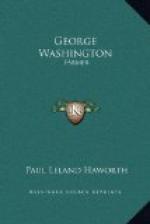No clearer statement of the differences between American and European agriculture has ever been formulated. Down to our own day the object of the American farmer has continued to be the same—to secure the largest return from the expenditure of a given amount of labor. But we are on the threshold of a revolution, the outcome of which means intensive cultivation and the realization of the largest possible return from a given amount of land.
That Washington saw the distinction so clearly is of itself sufficient proof that he pondered long and deeply upon agricultural problems.
CHAPTER IV
WASHINGTON’S PROBLEM
“No estate in United America,” wrote Washington to Arthur Young in 1793, “is more pleasantly situated than this. It lies in a high, dry, and healthy country, 300 miles by water from the sea, and, as you will see by the plan, on one of the finest rivers in the world. Its margin is washed by more than ten miles of tide water; from the beds of which and the innumerable coves, inlets, and small marshes, with which it abounds, an inexhaustible fund of mud may be drawn as a manure, either to be used separately or in a compost....
“The soil of the tract of which I am speaking is a good loam, more inclined, however, to clay than sand. From use, and I might add, abuse, it is become more and more consolidated, and of course heavier to work....
“This river, which encompasses the land the distance above mentioned, is well supplied with various kinds of fish at all seasons of the year; and, in the spring, with great profusion of shad, herring, bass, carp, perch, sturgeon, etc. Several fisheries appertain to the estate; the whole shore, in short, is one entire fishery.”
The Mount Vernon estate, amounting in the end to over eight thousand acres, was, with the exception of a few outlying tracts, subdivided into five farms, namely, the Mansion House Farm, the Union Farm, the Dogue Run Farm, Muddy Hole Farm and the River Farm.
On the Mansion House Farm stood the owner’s residence, quarters for the negroes and other servants engaged upon that particular estate, and other buildings. The land in general was badly broken and poor in quality; much of it was still in woodland.
The River Farm lay farthest up the Potomac, being separated from the others by the stream known as Little Hunting Creek. Visitors to Mount Vernon to-day, traveling by trolley, cross this farm and stream. It contained more tillable ground than any other, about twelve hundred acres. In 1793 it had an “overlooker’s” house of one large and two small rooms below and one or two rooms above, quarters for fifty or sixty negroes, a large barn and stables gone much to decay.
Muddy Hole Farm lay across Little Hunting Creek from the River Farm and back of the Mansion House Farm and had no frontal upon the Potomac. It contained four hundred seventy-six acres of tillable soil and had in 1793 a small overlooker’s house, “covering for about 30 negroes, and a tolerable good barn, with stables for the work-horses.”




